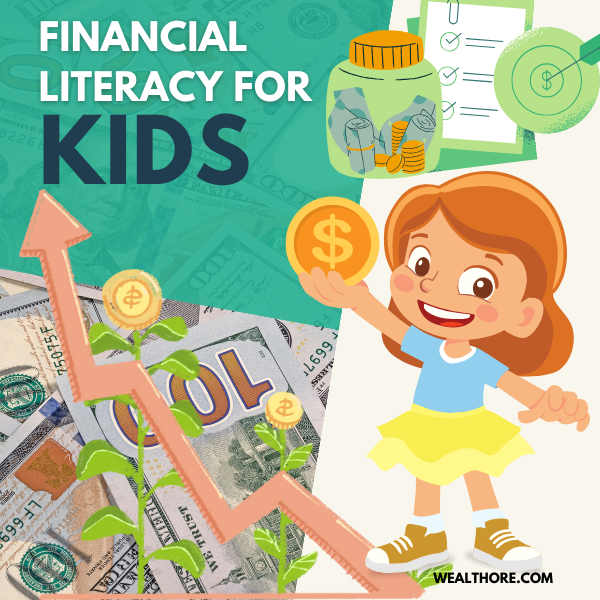Have you ever wondered how to teach your kids about money? It’s never too early to Teach Kids About Money and Finances, and it can be a lot of fun! This guide; Fun Ways to Teach Kids About Money and Finances will show you some creative ways to introduce children to basic financial concepts through games and activities.
1. Play Money Games
Monopoly Junior Monopoly Junior is a simplified version of the classic game. It helps kids learn about money, spending, and saving in a fun way. Playing this game regularly can teach kids about property ownership, rent, and the concept of earning money through investments.
The Allowance Game This board game teaches kids how to earn and spend money wisely. Players move around the board, collecting allowance and spending it on various items. This game is great for illustrating the importance of budgeting and saving for future needs.
Cashflow for Kids This game, created by Robert Kiyosaki, introduces children to basic financial concepts, including income, expenses, assets, and liabilities. It’s a Fun Ways to Teach Kids About Money and Finances. It way to show kids how financial decisions impact their overall financial health.
2. Set Up a Pretend Store
Grocery Store Set up a mini grocery store at home. Use play money and price tags. Let your kids shop, add up prices, and make change. This activity teaches them about budgeting, making choices based on price, and basic arithmetic.
Toy Store Create a toy store with your kids’ toys. Assign prices and let them “buy” and “sell” toys. This teaches them about value, decision-making, and the concept of exchanging money for goods.
Farmer’s Market Set up a pretend farmer’s market where your kids can sell fruits, vegetables, or handmade crafts. This can teach them about entrepreneurship and the basics of running a small business.
3. Use Real-Life Situations
Shopping Together When shopping, let your kids help you make decisions. Show them how to compare prices, choose the best value, and understand the concept of needs versus wants. Explain why you choose certain products over others based on price, quality, or necessity.
Saving for a Goal Help your kids set a savings goal, like buying a toy. Give them a piggy bank and encourage them to save part of their allowance. Use a chart to track their progress, making the goal tangible and achievable.
Paying Bills Together Show your kids how you pay bills, whether it’s utilities, rent, or groceries. Explain the importance of paying bills on time and how budgeting helps manage these expenses.
4. Teach Through Online Games and Apps
PiggyBot This app helps kids track their allowance and savings. It’s like a virtual piggy bank where they can save for specific goals. It’s user-friendly and makes learning about money management fun.
Savings Spree This app teaches kids about earning, spending, and saving through fun games and activities. It uses engaging graphics and interactive scenarios to teach financial responsibility.
Bankaroo A virtual bank for kids, Bankaroo allows children to track their allowance, set savings goals, and learn about money management in a practical, hands-on way.
5. Create a Chore Chart
Make a chore chart with tasks and rewards. Kids can earn money for completing chores, teaching them the value of work and saving.
Weekly Chores Assign chores like cleaning their room, taking out the trash, or helping with dishes. Pay them a small amount for each completed task, teaching them the relationship between work and earning money.
Special Projects Offer extra money for bigger tasks, like washing the car, gardening, or organizing the garage. This teaches kids about earning through effort and the value of hard work.
Tracking Earnings Use a chart to track the money they earn from chores. This visual aid helps them see how their efforts add up over time.
6. Storytime with Money Books
Read books that teach financial concepts. Some great choices are:
“Bunny Money” by Rosemary Wells This book follows Max and Ruby as they learn to budget their money during a shopping trip. It’s a fun and engaging way to introduce budgeting and financial planning.
“Alexander, Who Used to Be Rich Last Sunday” by Judith Viorst Alexander learns about spending and saving when he quickly spends all his money. This book teaches the importance of saving and the consequences of spending money impulsively.
“The Berenstain Bears’ Trouble with Money” by Stan and Jan Berenstain The Berenstain Bears learn about earning and saving money. It’s a great story to illustrate financial responsibility and the importance of saving for future needs.
7. Family Money Meetings
Have regular family meetings to discuss money matters. Involve your kids in budgeting and planning.
Budgeting Together Show your kids how you budget for groceries, bills, and fun activities. Explain why it’s important to save and how budgeting helps manage money effectively.
Planning Vacations Involve your kids in planning family trips. Let them see how much things cost, how to save for big expenses, and the importance of making financial decisions together.
Setting Financial Goals Discuss and set family financial goals, such as saving for a vacation or a new appliance. Show your kids how working together and saving money can help achieve these goals.
8. Encourage Entrepreneurial Activities
Encouraging Entrepreneurial Activities can be a Fun Ways to Teach Kids About Money and Finances. Help your kids start a small business to learn about earning and managing money.
Lemonade Stand Set up a lemonade stand in your yard. This teaches kids about costs, profits, and customer service. They learn to set prices, manage expenses, and interact with customers.
Craft Sales Encourage your kids to make crafts or baked goods and sell them to neighbors or at local markets. This activity teaches them about production costs, pricing, and profit margins.
Online Marketplaces Help older kids sell items on online marketplaces like Etsy or eBay. This introduces them to the concept of e-commerce and the basics of running an online business.
9. Use Educational Videos to Teach Kids About Money and Finances
Watch videos that teach financial literacy. There are many kid-friendly options available online.
“Sesame Street” Money Videos Sesame Street offers videos that teach kids about saving, spending, and sharing. These videos are fun and engaging, making financial concepts easy to understand.
“The Berenstain Bears’ Trouble with Money” This video helps kids understand the importance of saving money and working for what they want. It’s a great follow-up to the book.
Khan Academy Kids Khan Academy offers a range of videos that cover financial literacy topics for kids. These videos are interactive and educational.
10. Create a Simple Budget
Help your kids create a simple budget for their allowance or money they earn.
Income and Expenses Teach them to list their income (allowance, chores) and expenses (toys, snacks). Show them how to plan for saving and spending.
Savings Goals Encourage them to set savings goals for things they want to buy. This helps them understand the importance of planning and delayed gratification.
Tracking Spending Use a notebook or an app to track their spending. This visual representation helps kids see where their money goes and how they can manage it better.
Conclusion
Teach Kids About Money and Finances doesn’t have to be boring. By incorporating these activities into your child’s routine, you’ll help them build a solid foundation for understanding money and making smart financial decisions. Start today, and watch them grow into money-smart individuals!
For more tips and resources on financial literacy, visit WealthOre.com.
Have any creative ways to teach kids about money? Share your ideas in the comments below!







